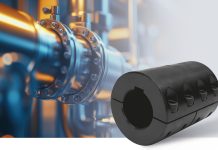When selecting hydraulic hoses, many industry veterans look to cover appearance – ‘wrapped’ versus ‘smooth’ – as a key indicator of a product’s attributes, such as durability, abrasion resistance and overall performance.

Gates, a leading global provider of application-specific fluid power and power transmission solutions, helps you determine the real difference between ‘wrapped’ and ‘smooth’ hydraulic hose covers.
Cindy Cookson, director of product line management, hydraulics of Gates, provides you with insights into specific properties of each component and discusses whether one style is ‘better’ than the other.
Why are hose cover appearances ‘wrapped’ and ‘smooth’?
The visual differences result from different hose curing methods during production. Many companies use both curing processes, choosing the most efficient and effective option based on the hose being manufactured. The considerations include cover materials, hose diameter, and processes before cover application.
What causes the appearance difference?
Wrapped covers consist of nylon fabric strips that are wrapped around the hose prior to curing. During the curing process pressure is applied and the material is consolidated. When the nylon is removed after curing, the textile weave and circumferential ridges where the nylon strips overlapped remain imprinted on the hose surface. Alternatively, for smooth covers, a plastic sheath is extruded around the hose. The plastic sheath applies pressure during curing and does not leave the circular ‘witness marks’ or fabric imprints. This is typically a more contemporary and efficient method of hose manufacturing.
So, which one is better?
‘Better’ is very difficult to quantify. Although this question may be directed at cover performance, our decisions are typically based on materials and processes being used. In head to-head comparison of both the wrapped and plastic sheath curing processes, Gates has demonstrated that there is no statistical difference between hoses in terms of performance specific to fit, form, function and crimp specs; assuming materials and other process parameters are identical.
Getting into cover performance, which cover appearance, wrapped or smooth, creates better abrasion resistance?
Simply put, and based on testing, neither curing method (wrapped or smooth cover) significantly impacts the abrasion resistance properties of the cover. Rather, the cover material itself determines the abrasion resistance of the hose.
The primary function of the hose cover is to protect the reinforcement from not only abrasion but ozone degradation. Which one wins here?
For those that do not know, ozone is a colorless gas found in our atmosphere and often concentrated around electrical equipment, welders and lighting. Ozone can react with materials and cause small cracks, which can over time lead to a hose cover performance issue. Material development or selection is important for limiting cracks, but cracks will appear due to a change in the surface shape. Look at your tires as an example. Cracks generally start near the brand lettering on a tire because it is easier for a crack to initiate in those areas. Given that a wrapped cover has surface changes and a smooth cover does not, all things being equal, a smooth hose cover should be more resistant to cracking caused by ozone exposure.
Are there any other differences between wrapped and smooth?
During installation, if a routing path is constricted or congested the circumferential ridges on a wrapped cover hose may catch or snag, whereas a smooth cover hose will not. So qualitatively, a smooth cover hose will be easier to route through a complex system.
What should I consider when determining the best hose cover for a particular use?
Both methods have their advantages and limitations, but the cover material has a greater impact on hose performance than the appearance or curing method. Although smooth hoses work best in many applications, Gates still produces wrapped-cover hoses for several reasons. First, it allows us to work with a wider range of cover materials that are incompatible with extruded plastic. Second, we can produce hoses in larger diameters. Finally, it allows us to efficiently make short production runs. Ultimately, it is about providing the best product for the job at the greatest value.
More about Gates can be found at www.gates.com.





